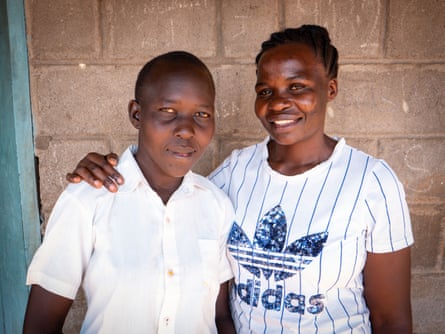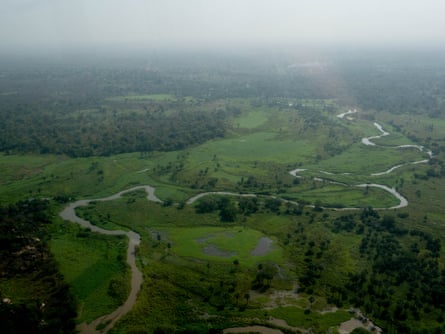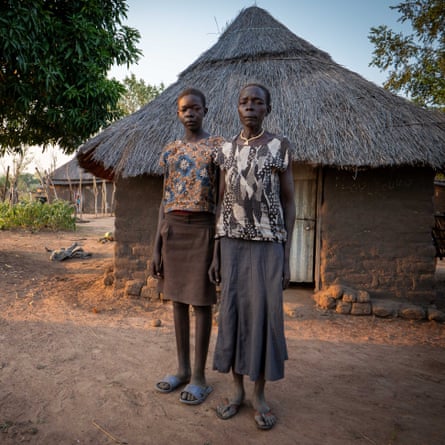Nodding syndrome is a distressing disease that stunts growth, harms brains and sparks convulsions. Though its cause is still unknown, there is now hope that epilepsy drugs can help afflicted children.
The other children move away, frightened when the convulsions start. Tabo takes a long, guttural breath before slumping onto the ground unconscious, her entire body shaking. The 17-year-old’s mother, Penina Monyo Gulu Biro, gently holds the girl while the attack lasts.
A minute or two later, Tabo (pictured above) sits up again, tears rolling down her cheeks. “She cries because she’s sad to be like this,” says Biro.
In 2016, Tabo was diagnosed with nodding syndrome, the neurological disorder that killed her 10-year-old sister, Nyibili.
Nodding syndrome was first identified in Tanzania in the 1960s; then, it was seen in South Sudan in the 1990s and in Uganda in 2007. In the past five years, cases have been reported in the Democratic Republic of the Congo, Central African Republic and Cameroon, according to Dr Gasim Abd-Elfarag, an expert on the disease who leads a South Sudanese charity, Access for Humanity.
But South Sudan’s Western Equatoria state, where Tabo’s home town of Mvolo is located, has the highest prevalence of nodding syndrome in the world, with more than 6,000 cases recorded at health facilities across four of the state’s 10 counties. “New cases are also being discovered in other counties, like Wulu, in Lakes state,” says Stephen Jada, a doctor and researcher with Amref Health Africa, the aid organisation leading the response in the country.
Amref is part of the Nodding Syndrome Alliance (NSA), a consortium of aid groups and universities established in 2019 that runs research programmes and specialised clinics in Maridi, Mundri West and Mundri East counties, which border Mvolo to the south.
There is no specialist clinic in Mvolo County. However, the area is a disease hotspot, with 3,000 cases, according to Lexon Bira, a local coordinator for the Relief and Rehabilitation Commission, a government-run humanitarian agency.
Remote villages have little to no access to the anti-epileptic drugs that can help manage symptoms.
The cause of nodding syndrome is still unknown, and no cure has been found for the disease. It affects children aged three and above and continues into adulthood. When it begins, head-nodding episodes are triggered by the sight of food and dropping temperatures.
Without epilepsy drugs, the condition worsens, with seizures potentially causing accidents and even death. Long-term effects include brain damage, stunted growth and mental impairment.
Affected children often become socially isolated as they are kept away from gatherings. “Children with nodding syndrome face different types of stigma, mainly because there is a lack of understanding of the condition, where it comes from and how it is transmitted,” says Sophia Mohammed, South Sudan director for one of the NSA charities, Light for the World, which supports disabled people and promotes eye health.
“They often don’t eat with others,” she says. “They are usually kept out of school, and those who attend school are often asked to sit separately from the rest of the class.
Lilian Sebit Doro’s daughter Grace died in 2019. “She died of malaria and chest pain,” says Lilian, who attributes her child’s death to nodding syndrome weakening her body. Two of her three remaining children also have the disease.
Her daughter, Roda Taban, who is 25, can experience up to “12 attacks in one night”, so Lilian sleeps in the same room to ensure Roda does not accidentally harm her baby when she starts convulsing.
Lilian’s 30-year-old son also has constant attacks. He is nearly blind due to onchocerciasis, known as river blindness, a disease caused by a parasitic worm transmitted by the bite of an infected black fly.

After losing her job as a cook for an international aid organisation that shut down its operations in Mvolo in 2022, Lilian could no longer afford epilepsy drugs. “I can’t tell what is causing this sickness, whether it’s the black fly or the killing of relatives,” she says, referring to local beliefs that nodding syndrome and epilepsy are a punishment for sharing food with someone who killed your relative without conducting cleansing rituals.
Researchers have identified a link between nodding syndrome, exposure to black-fly bites and onchocerciasis infection. The black fly breeds along fast-flowing rivers, such as the Mvolo River.
Jada, from Amref Health Africa, says: “We observed that among communities living near rivers, where onchocerciasis is very prevalent, cases of epilepsy and nodding syndrome are more numerous.
“The further you get from the river, the fewer cases. And when you go to villages where there is no river, where you do not observe black-fly bites, cases of nodding syndrome are rare, if not absent.”
Nodding syndrome is likely to be a form of “onchocerciasis-associated epilepsy”, says Jada, although he adds: “We don’t know how onchocerciasis could cause the disease.
“Tests have been carried out to see if the parasites reach the brain, or if they release a toxin that causes it, without success,” he adds. “This is all still under investigation.”

Several other theories have emerged to explain the upsurge of nodding syndrome cases in the region. Spoiled food aid, chemical weapons that could have been used during the civil war and nutritional deficiencies have all been investigated as potential causes, but “no conclusive results came out”, says Abd-Elfarag.
“It’s still a mysterious disease,” he says. “We’re still unable to put the puzzle together and understand its actual cause.”
Researchers have turned their attention to intervention studies centred on the black fly. These include slash-and-clear operations to eliminate the grass where the insect breeds. Health authorities now conduct campaigns twice a year to treat onchocerciasis with an anti-parasitic drug after decades of interruption due to the civil war and the years of instability that followed South Sudan’s independence 13 years ago.


In northern Uganda, as well as more recently in the South Sudanese town of Maridi, another hard-hit area of Western Equatoria, such interventions have made a difference: the number of new cases of nodding syndrome fell when both the black fly and onchocerciasis were eradicated.
A similar approach was introduced in Mvolo last year. Sitting on rocks by the Mvolo River, volunteers spend days catching black flies and trapping them in tubes, writing down the numbers collected every hour. The samples are then sent to the capital, Juba, and, from May this year, to the University of Antwerp for further analysis and to identify what percentage of black flies carry the parasite responsible for river blindness.
In Mundri, a more developed town 60 miles (100km) south of Mvolo, the specialised clinic run by NSA has registered 1,500 patients since it opened in 2020. Providing free epilepsy drugs has helped to reduce the frequency of seizures and head-nodding episodes.
“We’ve recorded 25 deaths so far, but the majority are now living a better life – they can work or go back to school,” says Joseph Yoto, the clinic’s nurse.
At Mundri Adventist primary school, only five of the 650 pupils are affected by nodding syndrome. “There are many more in the community, but parents still refuse to put them to school,” says Rebecca Aunty Ezbon, an education officer for the Sudan Evangelical Mission, which trains teachers on how to treat pupils with the condition.
Lukowe Christine Tina is one of the teachers. “I had that mentality – that if I touched [a pupil while they were convulsing], nodding will be transferred to me,” she says.

She learned that the disease was not contagious and was advised on the best way to respond during epileptic seizures. She noticed an improvement in those taking medication provided by the clinic and has become convinced of the potential of her pupils with the condition.
“Some of them like to play music with traditional instruments; others like debate activities in English,” she says. “We need to find out where they are most comfortable to express themselves and thrive in school.”
Negend Bouda, 19, had almost given up on school “because she felt scared and ashamed” after having convulsions in the classroom. But the teacher convinced her to return and spoke to her classmates.
Lukowe says: “We had to give them awareness: not to run away from her, that this disease cannot affect someone just by associating with the person. So they understood. And she managed to sit for her exams. She’s OK now; she’s following her medication, and she’s free.”
Bouda successfully passed her primary leaving certificate in December 2023. She calls her teacher her “best friend”.
“I hope to go on and study at the university,” she says,“ so I can become a doctor and help the many others with nodding syndrome, as well as those who are blind and disabled, so they can go back to school, be strong in their bodies, and work. People should not fear them.”
Article first published on https://www.theguardian.com/global-development/2024/mar/25/cure-nodding-syndrome-south-sudan-children-neurological-disorder-blackfly-onchocerciasis-river-blindness-link




